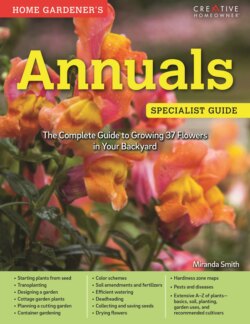Читать книгу Home Gardener's Annuals - Miranda Smith - Страница 8
На сайте Литреса книга снята с продажи.
Benefits of annuals
ОглавлениеWhat are annuals?
Annuals are wonderfully versatile plants. While some gardeners don’t consider annuals “serious” garden plants, most think they are indispensable. A far greater variety of annuals is available in garden centers and seed catalogs than ever before—every year, you find a wider choice of colors, forms, cultivars, and even species.
USING ANNUALS
When used intelligently, annuals can serve a host of functions. No longer the poor relations in a flower garden, they are planted in beds and borders, either by themselves or mixed with perennials. They burst into lavish bloom early and continue to provide color as perennials come and go throughout the season. Annuals make excellent companions to spring bulbs, and their leaves and flowers eventually hide the yellowing bulb foliage. They can be used to fill gaps between shrubs and foundation plantings or can be grown around tree trunks, where their massed colors can brighten the shade.
Many annuals are classic container and window-box plants; they bring instant color to patios, decks, porches, and rooftops. They can intermingle with vegetables and herbs to dress up the food garden or soften the harsh look of a front sidewalk and extend a welcome to your visitors.
Annuals are a convenient and easy way to grow flowers in a whole spectrum of colors; you can find an annual to fit into any color scheme. Many make excellent cut flowers, providing armloads of blossoms for lavish and inexpensive bouquets. Some can be potted up in autumn and brought indoors to continue flowering well into winter.
WHAT IS AN ANNUAL?
To botanists, an annual is a plant that completes its entire life cycle in a single growing season. But to gardeners, the category may also include biennial plants that will bloom from seed in one season if given an early start indoors, as well as tender perennials that are killed by frost and thus treated as annuals in all but frost-free climates.
The annual palette contains all the colors of the rainbow. This garden (below, left) contrasts golden marguerites and perennial tansy with purple heliotrope and verbena.
Fill a corner with color by combining hanging baskets and pots of annuals. In the garden shown below right, sweet alyssum and lobelia freshen a warm mix of petunias and nasturtiums.
Durable annuals
Annuals growing near driveways, streets, and sidewalks are subjected to stress from dust, fumes, and traffic. Choose tough plants like those listed below for these difficult locations.
• Cosmos (Cosmos species)
• Sunflower (Helianthus annuus)
• Blackfoot daisy (Leucanthemum paludosum)
• Zonal geranium (Pelargonium × hortorum)
• Petunia (Petunia × hybrida)
• Rose moss (Portulaca grandiflora)
• Marigold (Tagetes species)
ANNUALS BY HARDINESS
Hardy Annuals
Grow best in cool weather; tolerate a reasonable degree of frost
• Bachelor’s button (Centaurea cyanus)
• China pink (Dianthus chinensis)
• Flowering cabbage and kale (Brassica oleracea)
• Pansy (Viola x wittrockiana)
• Pot marigold (Calendula officinalis)
• Rocket larkspur (Consolida ambigua)
• Snapdragon (Antirrhinum majus)
• Sunflower (Helianthus annuus)
• Sweet alyssum (Lobularia maritima)
Rocket Larkspurs
Half-Hardy
Prefer cool weather but are damaged by repeated exposure to frost
• Blackfoot daisy, Melampodium (Leucanthemum paludosum, Melampodium leucanthum)
• Dahlberg daisy (Thymophylla tenuiloba)
• Dwarf morning-glory (Convolvulus tricolor)
• Edging lobelia (Lobelia erinus)
• Flowering tobacco (Nicotiana × sanderae)
• Licorice plant (Helichrysum petiolare)
• Marguerite (Argyranthemum frutescens)
• Marigold (Tagetes species)
• Mealycup sage (Salvia farinacea)
• Petunia (Petunia × hybrida)
• Scarlet sage (Salvia splendens)
• Spider flower (Cleome hassleriana)
• Strawflower (Helichrysum bracteatum)
• Yellow sage (Lantana camara)
Petunias
Tender
Need warm weather; can’t tolerate any frost
• Cardina cimber, Cypress vine (Ipomoea × mutifida, I. quamocit)
• China aster (Caistephus chinensis)
• Cockscomb (Ceosia argentea)
• Coeus (Soenostemon scutearioides)
• Cosmos (Cosmos bipinnatus, C. suphureus)
• Dusty mier (Senecio cineraria)
• Fanfower (Scaevoa aemua)
• Fossfower (Ageratum houstonianum)
• Fuchsia (Fuchsia hybrids)
• Gobe amaranth (Gomphrena gobosa)
• Heiotrope (Heiotropium arborescens)
• Impatiens, New Guinea impatiens (Impatiens species)
• ove-ies-beeding, Joseph’s coat (Amaranthus species)
• Madagascar periwinke (Catharanthus roseus)
• Mexican sunfower (Tithonia rotundifoia)
• Morning glory, moonfower (Ipomoea species)
• Nasturtium (Tropaeoum species)
• Nemesia (Nemesia strumosa)
• Rose moss (Portuaca grandifora)
• Sapphire flower (Browallia speciosa)
• Sweet potato vine (Ipomoea batatas)
• Wax begonia (Begonia Semperflorens-Cultorum hybrids)
• Wishbone flower (Torenia fournieri)
• Zinnia (Zinnia species)
• Zonal geranium, ivy geranium (Pelargonium species)
Zinnias
